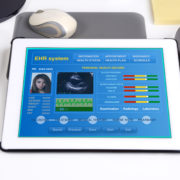How Does an Orthopedic EHR System Boost Office Productivity?
The Medical Group Management Association conducted a survey and it was found that nearly half of all respondents were displeased with their electronic medical record (EMR) systems. Why is this? It is most likely because EMRs do not have the capability to collaborate with other systems, meaning their meaningful use is significantly reduced. Fortunately, though, many medical offices, including orthopedic facilities, have made the switch to electronic health record (EHR) systems and they are enjoying a variety of benefits, with two of the most important being enhanced collaboration and increased productivity. For now, let’s take a look at the benefits of EHR and how this type of system can boost productivity in your orthopedic office.
Boosting More than Office Productivity
Before we dive into the ways an EHR system can boost office productivity, you should also know that this type of system can boost your profit levels. How? By enhancing operational efficiency and delivering a positive return on your EHR investment. As to be expected, to get the most out of your EHR system, it is very important that you and your employees receive proper training. The better the training, the more likely all features of the system can be used, therefore, the further the levels of productivity can be boosted.
Boosting Productivity In Your Orthopedic Office
Studies show that more than 60 percent of physicians who have made the switch to an EHR system have increased both their office productivity and sales revenue. These benefits are enjoyed in part because of the enhanced collaboration that takes place. When information is collected by primary care providers, it is essential that it be shared between various health providers to ensure the patient is receiving the best care possible. More so, this helps reduce the likelihood of duplicate testing from one medical provider to the next; this can increase profit margins because medical providers will be enjoying lower costs of care.
Boosting Continuity of Care
Probably the most advantageous aspect of an EHR system is that it has a health information exchange (HIE) feature, meaning it can migrate with a patient as he or she travels. For example, if a patient moves to a different part of the state, his health records can be uploaded to the HIE and accessed by different medical providers to help ensure there are not any unnecessary delays in treatment; this also helps to reduce clerical work for office staff members who are working on both ends of the switch.
Boosting Patient Engagement
Another reason your orthopedic office should make the switch to an EHR system is that it can boost patient engagement. Patients can be provided a portal to log into that enables them to log into their records and review lab results as well as physician notes; this boosts office productivity because it allows patients to access their information without having to take up the time of office staff members or physicians.
The Takeaway
It has been said that when patients are more involved in their health care, this can lead to better outcomes. With an EHR system in place, patients will be provided a convenient platform to access their healthcare data and medical professionals will have an organized platform for storing and sharing patient information with other healthcare professionals. If your orthopedic office is making the switch to an EHR system, you will find true interoperability by taking advantage of extensive EHR training. And while effective training will require an investment, it is this investment that will prove to be of the utmost value in obtaining a positive ROI.










